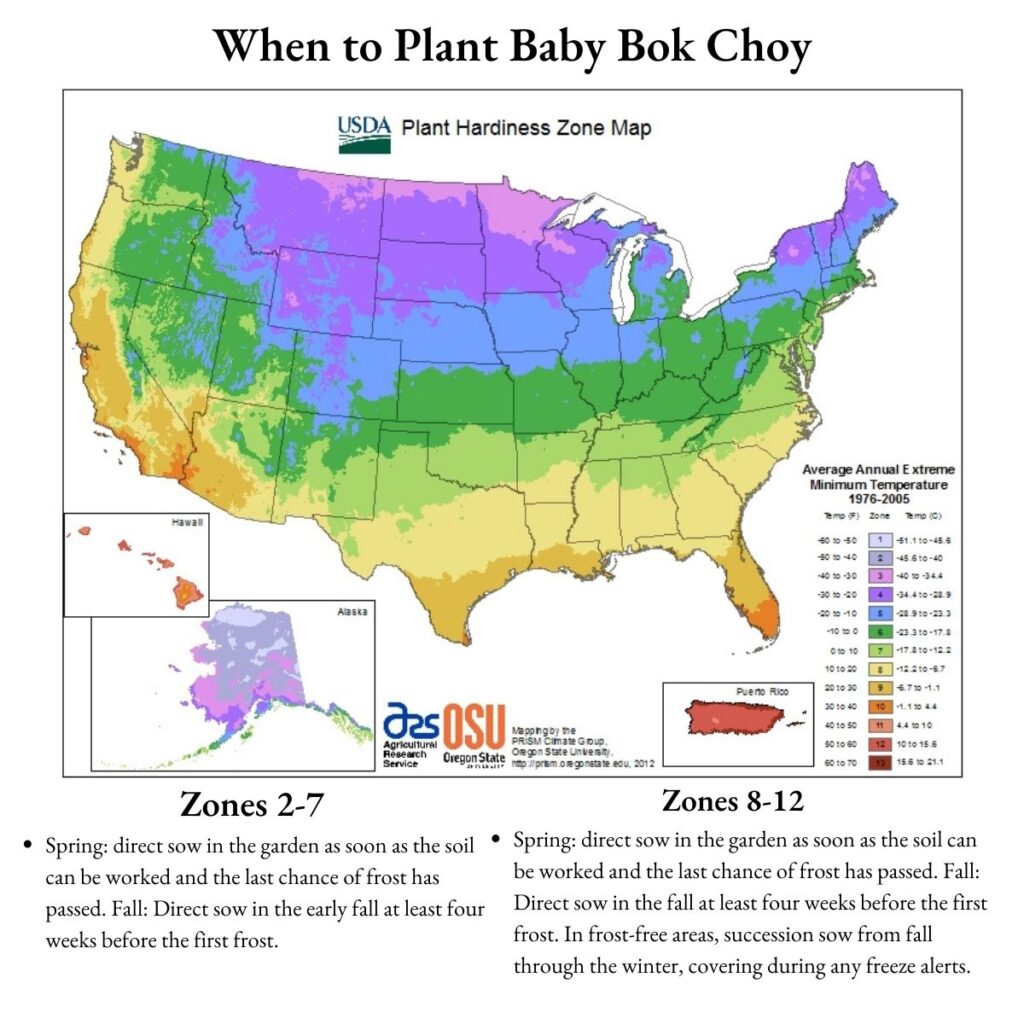Baby bok choy is a tender and flavorful vegetable that’s a staple in many Asian dishes. Growing baby bok choy from seed is also pretty easy. This variety matures in only 30 to 45 days, too.
When to Plant Baby Bok Choy
When is it time to grow your baby bok choy? Well, it depends on your climate zone.
In temperate zones, sow seeds in the spring once the last frost has passed. You can also plant in the fall if you start at least four weeks before your first frost.
In subtropical and tropical Zones 8-12, you can plant any time between September and March. You may have to cover if there is a freeze alert. In frost-free regions, don’t hesitate to plant throughout the winter. The biggest challenge will be if it gets too hot.

Preparing the Garden Bed
Find a sunny spot in your garden, one that gets about 4-6 hours of sunlight daily. In Zones 9-12, some midday shade is a good thing.
Clear out any weeds or debris and loosen the soil about 6-8 inches deep with a garden fork or broad fork.
Amend the soil with compost or well-rotted manure to boost fertility and drainage. A slightly acidic to neutral soil pH (around 6.0 to 7.0) is perfect.
Planting Your Baby Bok Choy
Plant your baby bok choy seeds about 1/4 deep in garden rows placed at least 8-10″ inches apart. Gently press the seeds down into the soil to increase contact with the soil.
Water with a light misting setting to prevent displacing the seeds. Keep the soil consistently moist, misting regularly, until germination.
After about two weeks, give your growing bok choy a little boost with a balanced, all-purpose fertilizer.
Thinning Your Bok Choy
When your seedlings reach a few inches in height and have a few true leaves, it’s thinning time.
Give each plant 6-8 inches of personal space.
Caring for Your Growing Baby Bok Choy
Consistent watering is a must. In the scorching heat of summer, a little shade can prevent your bok choy from getting stressed out and bolting.
Pests like aphids and cabbage worms may come calling. We recommend using an organic pest spray that contains Spinosad for caterpillars and cabbage worms.
Aphids can be removed with a vigorous spray of water from the hose. You can also try a high-quality neem oil.
Snails and slugs like to eat bok choy, too, but you can discourage them with Sluggo, a safe, organic slug pellet.
Harvest Time
Your baby bok choy will be at its best between 30-45 days after germination.
These guys are tiny — only 3-4″ tall.
Use a sharp knife to cut the leaves and stems right at the base, just above the soil line.
Cleaning and Storing Your Baby Bok Choy
You’ve picked your produce, now let’s prepare it for the kitchen.
Give your freshly harvested bok choy a good rinse under cold water to get rid of any lingering dirt.
Then, to ensure that there are no pests on your delicious organic cabbages, fill a sink with cold water and mix in 1/4 cup of salt and 1/4 cup of vinegar.
Add the rinsed cabbage heads to the water and let them soak for about 20 to 30 minutes.
Then, rinse them again and store them in a plastic bag or container in the fridge. They should stay crisp and fresh for about a week.
If you can’t eat them within a week, you can blanch them for 30 seconds in boiling water, cool them in an ice bath, and then store them in a freezer bag in the freezer for up to 3 months for cooked cabbage dishes.

Cooking with Baby Bok Choy
The best part – savoring your homegrown bok choy!
Stir-fry it with some garlic and ginger for a simple yet delicious side dish.
Steam it until tender, then drizzle with a soy sauce and sesame oil blend.
Sauté bok choy with a splash of olive oil, a pinch of red pepper flakes, and a squeeze of lemon for a zesty kick.
Add baby bok choy to your favorite soups or salads for a crunchy and nutritious twist.
Use the small leaves as wraps for bulgogi or Asian-style chicken salad.
There you have it, from seed to table! Growing baby bok choy and using it in your own homemade meals is a rewarding experience.





